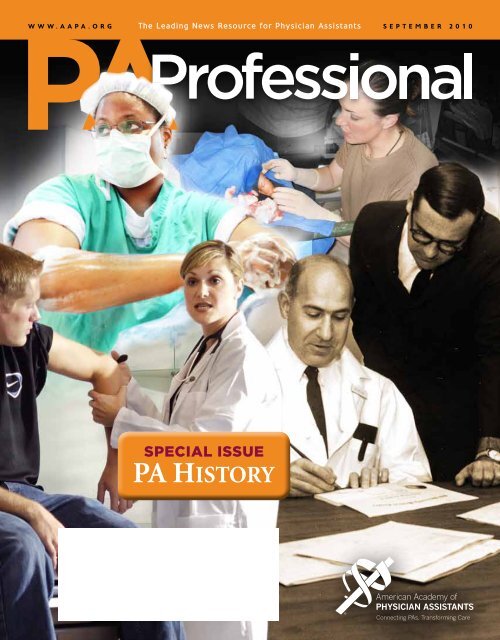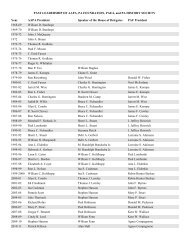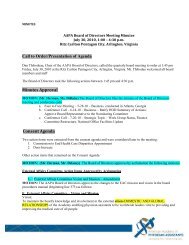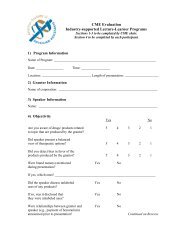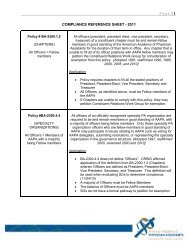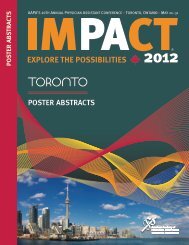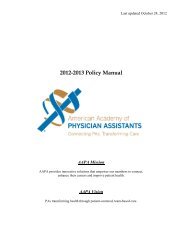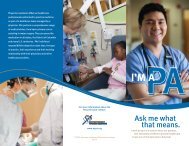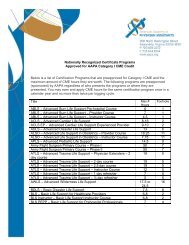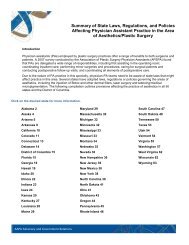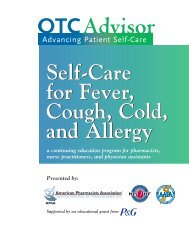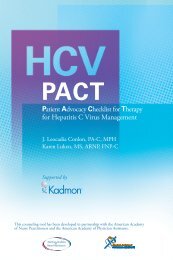PA History - American Academy of Physician Assistants
PA History - American Academy of Physician Assistants
PA History - American Academy of Physician Assistants
Create successful ePaper yourself
Turn your PDF publications into a flip-book with our unique Google optimized e-Paper software.
w w w . a a p a . o r g The Leading News Resource for <strong>Physician</strong> <strong>Assistants</strong> s e p t e m b e r 2 0 1 0<br />
Special issue<br />
<strong>PA</strong> <strong>History</strong>
PRESIDENT’S LETTER<br />
V O L 2 | N O 8 | s e p t e m b e r 2 0 1 0<br />
W W W. A A <strong>PA</strong> . O R G<br />
AA<strong>PA</strong> BOARD OF DIRECTORS<br />
President<br />
Patrick E. Killeen, MS, <strong>PA</strong>-C<br />
Chair <strong>of</strong> the Board/secretary<br />
Daniel T. Thibodeau, MHP, <strong>PA</strong>-C, DFAA<strong>PA</strong><br />
immediate past president<br />
Stephen H. Hanson, M<strong>PA</strong>, <strong>PA</strong>-C<br />
President-Elect<br />
Robert L. Wooten, <strong>PA</strong>-C<br />
Vice President/Speaker, House <strong>of</strong> Delegates<br />
Alan Hull, <strong>PA</strong>-C<br />
Treasurer<br />
Bruce C. Fichandler, <strong>PA</strong><br />
First Vice Speaker, House <strong>of</strong> Delegates<br />
James E. Delaney, <strong>PA</strong>-C<br />
Second Vice Speaker, House <strong>of</strong> Delegates<br />
L. Gail Curtis, M<strong>PA</strong>S, <strong>PA</strong>-C<br />
Director at Large<br />
Michelle O. DiBaise, M<strong>PA</strong>S, <strong>PA</strong>-C<br />
Director at Large<br />
Jeffrey Katz, <strong>PA</strong>-C<br />
Director at Large<br />
Michael C. Doll, M<strong>PA</strong>S, <strong>PA</strong>-C, DFAA<strong>PA</strong><br />
Director at Large<br />
Lawrence M. Herman, M<strong>PA</strong>, R<strong>PA</strong>-C, DFAA<strong>PA</strong><br />
Student Representative<br />
Mark M. Shepherd<br />
magazine staff<br />
executive vice president/chief executive <strong>of</strong>ficer<br />
Bill Leinweber<br />
Chief Operating Officer<br />
Sabrina Smith, DrHA<br />
Vice President, Communications<br />
Howard Glassroth<br />
Director, Publications<br />
Christopher Doscher<br />
<strong>PA</strong> Pr<strong>of</strong>essional Staff<br />
Ashley Kent, Janette Rodrigues<br />
PublicatioN Design and Production<br />
BonoTom Studio, Inc.<br />
www.bonotom.com<br />
advertising sales<br />
dominic barone<br />
haymarket media, inc.<br />
646-638-6097<br />
dominic.barone@haymarketmedical.com<br />
Living <strong>History</strong><br />
Most <strong>of</strong> us associate our first exposure<br />
to the term “history” with our elementary<br />
school years. Back then, the term most<br />
likely went along with images <strong>of</strong> Egyptian tombs,<br />
dinosaurs, the Founding Fathers or wars fought long<br />
before we were born. I think all <strong>of</strong> us have wondered<br />
what it would be like if we could speak to the people<br />
we read about in history books and find out how<br />
their perspectives might differ from the authors’.<br />
Our pr<strong>of</strong>ession’s own history extends back only<br />
45 years, but it is rich with intrigue, impact and<br />
colorful characters. We’re lucky in that many <strong>of</strong> the<br />
pioneers who were there at the beginning <strong>of</strong> the pr<strong>of</strong>ession<br />
are still around and enjoy talking to us about<br />
the early days and how the pr<strong>of</strong>ession has changed.<br />
There aren’t many pr<strong>of</strong>essions that have the same opportunity to hear firsthand, in-person<br />
accounts <strong>of</strong> history so important to what they do. These opportunities don’t last forever, so it’s<br />
important to take advantage <strong>of</strong> them.<br />
This issue <strong>of</strong> <strong>PA</strong> Pr<strong>of</strong>essional features stories <strong>of</strong> some <strong>of</strong> the most important aspects <strong>of</strong> our<br />
pr<strong>of</strong>ession’s history. Several <strong>of</strong> the individuals who have been around since the early days have<br />
graciously donated their time to contribute articles to this issue. While all the details <strong>of</strong> a 45-year<br />
history are far too numerous to fit into one magazine, we hope that what we have included will<br />
drive you to learn more about the pr<strong>of</strong>ession’s roots. The best resource for this is the web site <strong>of</strong><br />
the Society for the Preservation <strong>of</strong> <strong>PA</strong> <strong>History</strong> at www.pahx.org. Take a few minutes to browse<br />
through the many documents, photographs and articles that have been written by <strong>PA</strong>s, physicians<br />
and others who helped build the foundation for <strong>PA</strong>s.<br />
I hope you enjoy learning more about our pr<strong>of</strong>ession’s roots and that what you learn enriches<br />
your experiences and strengthens your sense <strong>of</strong> purpose as a <strong>PA</strong>. Never forget that as far as we’ve<br />
come, there is still more history to be made.<br />
<strong>PA</strong><br />
Patrick Killeen, MS, <strong>PA</strong>-C<br />
AA<strong>PA</strong> President, 2010–2011<br />
950 N. Washington St.<br />
Alexandria, VA 22314-1552<br />
p: 703-836-2272 | f: 703-684-1924<br />
e: aapa@aapa.org | w: www.aapa.org<br />
To place a <strong>PA</strong> Career ad, call 800-983-7737<br />
Copyright ©2010 by the <strong>American</strong> <strong>Academy</strong> <strong>of</strong> <strong>Physician</strong> <strong>Assistants</strong>,<br />
<strong>PA</strong> Pr<strong>of</strong>essional is published monthly and is a registered trademark<br />
<strong>of</strong> the AA<strong>PA</strong>, 950 N. Washington St., Alexandria, VA 22314-1552. It<br />
is distributed exclusively to AA<strong>PA</strong> members. Membership rates are<br />
$250 annually, <strong>of</strong> which $15 is applied to the cost <strong>of</strong> the periodical.<br />
Periodical postage paid at Alexandria, Va. and additional mailing <strong>of</strong>fices.<br />
Permission to reprint <strong>PA</strong> Pr<strong>of</strong>essional is granted, provided credit is given<br />
to the publication. Letters to the editor and contributed articles are not<br />
necessarily the opinion <strong>of</strong> <strong>PA</strong> Pr<strong>of</strong>essional or AA<strong>PA</strong>. Only signed letters<br />
to the editor are accepted. All articles and letters are subject to editing.<br />
POSTMASTER: Send changes <strong>of</strong> address to <strong>PA</strong> Pr<strong>of</strong>essional, 950 N.<br />
Washington St., Alexandria, VA 22314-1552. ISSN 0894-0509.<br />
<strong>PA</strong> PROFESSIONAL | SEPTEMBER 2010 | WWW.AA<strong>PA</strong>.ORG | 5
A<br />
<strong>of</strong><br />
<strong>History</strong><br />
Service<br />
B y A s h l e y K e n t<br />
Rear Adm. Michael Milner is one <strong>of</strong> the highest-ranking<br />
federal service <strong>PA</strong>s in the country. In addition to serving as chief<br />
health services <strong>of</strong>ficer in the United States Public Health Service,<br />
he also serves as assistant U.S. surgeon general and as regional<br />
health administrator for the six New England states. He led<br />
public health efforts during three Florida hurricanes in 2004<br />
and helped get the New Orleans health system up and running<br />
after hurricanes Katrina and Rita.<br />
Milner, a former president <strong>of</strong> the<br />
AA<strong>PA</strong> Veterans Caucus, is an example <strong>of</strong><br />
<strong>PA</strong> military success in a pr<strong>of</strong>ession that began with veterans<br />
with vast medical experience. He credits the pr<strong>of</strong>ession’s military<br />
roots with shaping his own journey as a <strong>PA</strong>.<br />
“I still feel the connection to those first <strong>PA</strong>s and the combat<br />
medics and corpsmen <strong>of</strong> the Vietnam era,” said Milner, who<br />
began his career in the Air Force, then transferred to the<br />
Commissioned Corps <strong>of</strong> the U.S. Public Health Service in<br />
1989. “They made a mark on me and I silently thank them<br />
every day for helping me become a <strong>PA</strong>.”<br />
Rear Adm. Michael Milner<br />
Maj. Dennis Hays, one<br />
<strong>of</strong> the first <strong>PA</strong>s to hold a <strong>PA</strong>-specific<br />
clinical doctorate degree from the<br />
Army <strong>PA</strong> doctoral program.<br />
16 | <strong>PA</strong> PROFESSIONAL | SEPTEMBER 2010 | WWW.AA<strong>PA</strong>.ORG
Gene<br />
Jones in<br />
October<br />
1974, the<br />
day he<br />
completed<br />
phase one<br />
<strong>PA</strong> training<br />
at Sheppard<br />
Air Force<br />
Base, Texas.<br />
The <strong>PA</strong><br />
Pr<strong>of</strong>ession’s<br />
Military<br />
Roots<br />
<strong>PA</strong> <strong>History</strong><br />
Timeline<br />
<strong>PA</strong> William Tozier examines a Honduran patient<br />
as part <strong>of</strong> an Army Medical Civilian Aid Project<br />
in the mountains <strong>of</strong> Honduras in 1983.<br />
<strong>PA</strong> PROFESSIONAL | SEPTEMBER 2010 | WWW.AA<strong>PA</strong>.ORG | 17
A A P A<br />
A<br />
<strong>of</strong><br />
<strong>History</strong><br />
Service<br />
Military Roots <strong>of</strong> the<br />
Duke <strong>PA</strong> Program<br />
The three ex-Navy corpsmen who were<br />
the first <strong>PA</strong> students at Duke University<br />
certainly never knew how their decision<br />
to take a chance on this new career would<br />
impact the thousands who would follow<br />
in their footsteps. But Duke physician<br />
Eugene Stead Jr. saw the value in their<br />
Vic Germino<br />
military medical training, and knew<br />
it could help alleviate the primary care shortage. And so, in 1965,<br />
Vic Germino, Ken Ferrell, Dick Scheele and Don Guffey (who later<br />
dropped out), began their training as the first <strong>PA</strong> students.<br />
Ferrell, who at 21 was the youngest student, left active duty in the<br />
Navy a month early in order to begin <strong>PA</strong> school. Right around that<br />
same time, many <strong>of</strong> his fellow sailors were being sent to Vietnam. “I<br />
might not be here today if I hadn’t been in that first <strong>PA</strong> class,” he noted.<br />
Ferrell was intrigued by the prospect <strong>of</strong> receiving an education to<br />
support his hands-on experience. “I felt like I didn’t have anything to<br />
lose,” Ferrell said. “It was getting time for me to get out <strong>of</strong> the Navy, and<br />
I had no idea what I was going to do or where I was going to work.”<br />
In the 1960s, it was common for military medics or corpsmen to<br />
return from years <strong>of</strong> combat medical experience, only to be rejected<br />
by the civilian health sector. According to Ann Suter Ford’s 1975<br />
book The <strong>Physician</strong>’s Assistant: A<br />
National and Local Analysis, <strong>of</strong><br />
the 30,000 medics who were discharged<br />
annually from the service<br />
around 1970, only about a third<br />
found their way into civilian<br />
health employment positions.<br />
(Editor’s note: In the early days<br />
<strong>of</strong> the pr<strong>of</strong>ession, “physician’s<br />
assistants” was an acceptable<br />
way to refer to <strong>PA</strong>s.)<br />
Vic Germino at age 23, posing in<br />
front <strong>of</strong> Gibraltar as a Merchant Marine.<br />
“It was looked at as about all that we<br />
were good for was to be an orderly or<br />
something like that,” said Germino, who<br />
was working in surgery and the OR at Duke<br />
when he was selected for the program.<br />
“That’s where Dr. Stead, seeing beyond that<br />
in all the training that we had, made me feel<br />
good about what he was trying to do.”<br />
According to Germino, Stead treated his<br />
Ken Ferrell<br />
<strong>PA</strong> students a lot like medical residents, taking<br />
them on rounds and even allowing them to see patients within the<br />
first few months <strong>of</strong> their didactic training. The intense training paid <strong>of</strong>f.<br />
Twenty-year-old <strong>PA</strong> Gino Gianola in 1966, caring for orphans<br />
in Vietnam during his time as an Army specialist.<br />
1942<br />
1959<br />
1964<br />
Eugene Stead, Jr., MD,<br />
is forced to develop<br />
a fast track, 3-year<br />
applied medical<br />
curriculum to educate<br />
physicians at Emory<br />
University for military<br />
service during World<br />
War II.<br />
Surgeon General<br />
identifies shortage<br />
<strong>of</strong> medically trained<br />
personnel.<br />
1961<br />
Charles Hudson, MD, in the<br />
Journal <strong>of</strong> the <strong>American</strong><br />
Medical Association, calls<br />
for a mid-level provider<br />
from the ranks <strong>of</strong> former<br />
military corpsmen.<br />
Eugene Stead Jr.,<br />
MD, decides that<br />
ex-military corpsmen<br />
with their previous<br />
training and<br />
experience would be<br />
suitable candidates<br />
for his two-year<br />
experimental<br />
program.<br />
18 | <strong>PA</strong> PROFESSIONAL | SEPTEMBER 2010 | WWW.AA<strong>PA</strong>.ORG
“Toward the end <strong>of</strong> the first year we took our medical<br />
skill test just like the Duke medical students, and we scored<br />
just as high as they did,” Germino said.<br />
“Working up a patient in a hospital and doing some basic<br />
lab work was probably easier for us than it was for the medical<br />
students because we had already seen so many patients<br />
in the military,” said Ferrell, who had cared for fellow sailors<br />
on his Navy ship without the support <strong>of</strong> a physician. “I<br />
think they were surprised that so many <strong>of</strong> the tasks that<br />
had previously only been done by the physician or medical<br />
student could be done by someone with less time in the classroom.”<br />
Germino noted that soon after the <strong>PA</strong> program began, Duke<br />
changed its medical school curriculum to begin clinical training sooner.<br />
Germino, Ferrell and Scheele graduated from the Duke <strong>PA</strong> program<br />
on October 6, 1967. All three went to work at Duke after graduation.<br />
Germino later ended up serving 10 years in the Coast Guard as a<br />
<strong>PA</strong>, including three years in Alaska doing helicopter search and rescue<br />
operations. Ferrell remained at Duke, working in clinical practice for<br />
an allergist, then as a coding expert. Tragically, Dick Scheele died in<br />
1970 at the age <strong>of</strong> 31, just three years after graduating from the Duke<br />
program. Before his death he was able to help establish the <strong>American</strong><br />
Association <strong>of</strong> <strong>Physician</strong>’s <strong>Assistants</strong>, which eventually became the<br />
<strong>American</strong> <strong>Academy</strong> <strong>of</strong> <strong>Physician</strong> <strong>Assistants</strong>.<br />
Military Roots <strong>of</strong> the MEDEX program<br />
Two years after Duke graduated the first three <strong>PA</strong>s, Richard Smith, MD<br />
launched the MEDEX, or Medicine Extension, program at the University<br />
<strong>of</strong> Washington with 15 former military corpsmen as a way to<br />
lighten the workload <strong>of</strong> rural primary care physicians in the Northwest.<br />
According to Gino Gianola, a graduate <strong>of</strong> the eighth MEDEX class<br />
and lecturer in the MEDEX Northwest <strong>PA</strong> program, the first class<br />
was made up <strong>of</strong> mostly special forces veterans who could successfully<br />
promote the pr<strong>of</strong>ession to the public.<br />
Gianola had heard about the pr<strong>of</strong>ession while he was serving in Vietnam<br />
as an Army clinical specialist. When he came back to the United<br />
Army 1st Lt. Jessica Larson, <strong>PA</strong>-C,<br />
treats an Iraqi child during a one-day, combined<br />
U.S.-Iraqi medical clinic in Kubaysah, Iraq, June 6, 2010. U.S.<br />
Photo by Army Spc. Katie Summerhill<br />
States two years later, he found it hard to find a civilian job with his military<br />
training. He went to work as an orderly at a children’s orthopedic<br />
hospital and later took the Washington state exam to become an LPN.<br />
But it was this new physician assistant pr<strong>of</strong>ession that really intrigued<br />
him. He was admitted into the 4th MEDEX class, but was asked to leave<br />
after a disagreement with Smith about <strong>PA</strong> placement in inner cities.<br />
Gianola returned to MEDEX a few years later, graduating from<br />
its eighth class and returning as faculty. Shortly after graduation he<br />
worked with psychiatrist and Navy veteran Jim McDermott, then a<br />
Washington state legislator and now a U.S. congressman.<br />
“He knew what corpsmen and medics could do, and thought [the<br />
<strong>PA</strong> pr<strong>of</strong>ession] was a very good use <strong>of</strong> that experience. He helped<br />
sponsor the legislation [for <strong>PA</strong>s to practice in Washington.]”<br />
Early <strong>PA</strong>s in the Military: the Battle for Rank<br />
But even as <strong>PA</strong>s were making progress in the civilian world, they were<br />
facing roadblocks gaining rank in the military. <strong>PA</strong> Gene Jones, PhD,<br />
<strong>PA</strong> program director at the University <strong>of</strong> Texas Southwestern Medical<br />
Center, remembers the battles he and others faced during his early<br />
days as a Navy <strong>PA</strong> in the mid 1970s.<br />
1965<br />
1966<br />
1964<br />
Richard A. Smith, MD,<br />
develops the MEDEX<br />
(Med-icine Ex-tension)<br />
model with a strong<br />
emphasis on the<br />
deployment <strong>of</strong> students<br />
and graduates into<br />
medically underserved<br />
communities.<br />
Academic committee<br />
chaired by Andrew<br />
Wallace, MD, approves<br />
Stead’s proposed <strong>PA</strong><br />
curriculum and the<br />
National Heart Institute<br />
funds physician Herbert<br />
Saltzman’s grant to train<br />
hyperbaric chamber<br />
operators and physician<br />
assistants. This clears<br />
the way for the first four<br />
<strong>PA</strong> students, all ex-Navy<br />
hospital corpsmen, to<br />
begin training at the Duke<br />
University Medical Center<br />
in Durham, NC.<br />
Allied Health Pr<strong>of</strong>essions<br />
Personnel Act (PL-<br />
751) promotes the<br />
development <strong>of</strong> programs<br />
to train new types <strong>of</strong><br />
primary care providers.<br />
Look Magazine article<br />
entitled “More than a<br />
nurse, less than a doctor”<br />
catapults the <strong>PA</strong> concept<br />
to national attention.<br />
1967<br />
First class <strong>of</strong> three <strong>PA</strong>s, Kenneth F. Ferrell, Victor H. Germino, and Richard J.<br />
Scheele, graduate from Duke University on October 6. The <strong>American</strong> <strong>Academy</strong> <strong>of</strong><br />
<strong>Physician</strong> <strong>Assistants</strong> adopts the date later as “National <strong>PA</strong> Day.”<br />
<strong>PA</strong> PROFESSIONAL | SEPTEMBER 2010 | WWW.AA<strong>PA</strong>.ORG | 19
A A P A<br />
A<br />
<strong>of</strong><br />
<strong>History</strong><br />
Service<br />
“We were in an in-between category <strong>of</strong> not being enlisted yet not<br />
fully commissioned as <strong>of</strong>ficers, and we started <strong>of</strong>f as <strong>PA</strong>s at the bottom<br />
rank designation <strong>of</strong> W-1. Now that was an interesting uniform,”<br />
said Jones, who reached the rank <strong>of</strong> W-4 and served as <strong>PA</strong> specialty<br />
advisor to the Navy surgeon general. “Vice Admiral James A. Zimble<br />
asked me to continue to be patient about full commissioning for<br />
Navy <strong>PA</strong>s in the Medical Service Corps and I responded that we could<br />
wait no longer. A number <strong>of</strong> us were eligible to retire and soon chose<br />
to do so. A few months later the commissioning was authorized.”<br />
That was in 1989. Jones was <strong>of</strong>fered the option <strong>of</strong> returning to<br />
active duty status as a lieutenant with time-in-grade toward lieutenant<br />
commander, but declined because he was enrolled in a PhD<br />
program at the time.<br />
In 1992, Army and Coast Guard <strong>PA</strong>s were commissioned. Air<br />
Force <strong>PA</strong>s were the first to be commissioned in 1978.<br />
Members <strong>of</strong> the Naval Medical Command EMT Training Program<br />
in June 1986 at the Marine Corps base in Camp Pendleton, Calif.<br />
<strong>PA</strong> Gene Jones (third from left) and others trained Navy hospital<br />
corpsmen and all west coast SEAL team members as EMTs.<br />
<strong>PA</strong>s Today: Rising in the Ranks<br />
It’s hard for some <strong>of</strong> the first <strong>PA</strong>s to imagine the freedom that <strong>PA</strong>s in<br />
the military enjoy today. “It’s amazing to see what is out there now for<br />
<strong>PA</strong>s to do,” Germino said. “There’s one that’s in charge <strong>of</strong> a medical<br />
brigade. I would have given anything to have done that.”<br />
He’s referring to Col. Michael Robertson, who will be the first <strong>PA</strong><br />
to command a medical brigade when he takes command <strong>of</strong> the Army’s<br />
18th medical brigade in Hawaii next summer. He’ll be in charge <strong>of</strong><br />
active duty, reserve and National Guard units for the Pacific theater.<br />
“I was really humbled when they picked me up for another command.<br />
Because besides being a first for a <strong>PA</strong>, it’s also the first for an<br />
Army medical specialist corps <strong>of</strong>ficer,” Robertson said. “It’s a pretty<br />
big deal for the young <strong>PA</strong>s that I’m doing this because it opens up a<br />
lot <strong>of</strong> opportunities for them down the road.”<br />
<strong>PA</strong>s from all branches <strong>of</strong> military are trained at the Interservice<br />
<strong>Physician</strong> Assistant Program at Fort Sam Houston in Texas. Graduates<br />
receive a Master <strong>of</strong> <strong>Physician</strong> Assistant Studies degree from the<br />
University <strong>of</strong> Nebraska. <strong>PA</strong> and Program Director Col. William<br />
Tozier says Robertson and Lt. Col. John Balser, who recently took<br />
over Robertson’s former post as assistant corps chief <strong>of</strong> the Army<br />
Medical Specialist Corps, have set an important precedent for <strong>PA</strong>s<br />
in the military.<br />
“When I came into the Army, <strong>PA</strong>s thought <strong>of</strong> themselves only as<br />
clinicians. In turn, this reflected how <strong>PA</strong>s were viewed by others. These<br />
two <strong>PA</strong>s have shattered these old, constraining views and added a whole<br />
new dimension to how <strong>PA</strong>s are respected by the military,” Tozier said.<br />
Robertson, who joined the Army in 1972, noted that the war has<br />
created an even greater demand for <strong>PA</strong>s in the military.<br />
“This war changed things for <strong>PA</strong>s. When the war came around, the<br />
Army decided that they needed to keep experienced <strong>PA</strong>s.” Robertson<br />
did what he could to make sure that happened. “One <strong>of</strong> the things I<br />
accomplished while I was a consultant was bonus pay for <strong>PA</strong>s—31 thousand<br />
dollars a year—which keeps a lot more <strong>of</strong> them in the Army now.”<br />
Robertson said the number <strong>of</strong> <strong>PA</strong>s in the Army has doubled since<br />
the war began, and he expects that number to grow another 50 percent<br />
in the next five to ten years. “There’s plenty <strong>of</strong> room for growth<br />
and there’s plenty <strong>of</strong> leadership opportunities for them,” he said.<br />
According to the AA<strong>PA</strong> Census combined with data from the National<br />
Commission on Certification <strong>of</strong> <strong>Physician</strong> <strong>Assistants</strong>, there are<br />
1968<br />
1969<br />
1969<br />
1970<br />
1968<br />
Hu C. Myers, MD,<br />
establishes first<br />
baccalaureate degree<br />
program for <strong>PA</strong>s at<br />
Alderson-Broaddus<br />
College in Philippi, W. Va.<br />
Health Manpower Act<br />
(PL-490) funds the<br />
training <strong>of</strong> a variety <strong>of</strong><br />
health providers.<br />
Duke University hosts<br />
first <strong>of</strong> four national<br />
conferences on physician<br />
assistants on issues such<br />
as education, promotion <strong>of</strong><br />
the pr<strong>of</strong>ession, and model<br />
legislation for <strong>PA</strong>s.<br />
1968<br />
AA<strong>PA</strong> is incorporated<br />
in N.C.<br />
Richard Smith, MD,<br />
launches MEDEX program<br />
at the University <strong>of</strong><br />
Washington.<br />
The <strong>American</strong> Hospital<br />
Association and the Joint<br />
Commission release a<br />
report on the “Utilization<br />
<strong>of</strong> <strong>Physician</strong>’s <strong>Assistants</strong> in<br />
the Hospital.”<br />
<strong>American</strong> Medical<br />
Association Council on<br />
Health Manpower explores<br />
<strong>PA</strong> concept and the<br />
AMA House <strong>of</strong> Delegates<br />
adopts “Guidelines for<br />
the Development <strong>of</strong> New<br />
Health Occupations.”<br />
Board <strong>of</strong> Medicine <strong>of</strong> the<br />
National <strong>Academy</strong> <strong>of</strong><br />
Sciences releases report<br />
classifying <strong>PA</strong>s as Type<br />
A, B, or C according to<br />
degree <strong>of</strong> specialization<br />
and level <strong>of</strong> judgment.<br />
The <strong>American</strong> Registry<br />
<strong>of</strong> <strong>Physician</strong> Associates is<br />
incorporated in N.C. Later,<br />
the registry is absorbed<br />
into the Association<br />
<strong>of</strong> <strong>Physician</strong> Assistant<br />
Programs (now <strong>PA</strong>EA) and<br />
its certification functions<br />
are assumed by the<br />
National Commission on<br />
Certification <strong>of</strong> <strong>Physician</strong><br />
<strong>Assistants</strong>.<br />
20 | <strong>PA</strong> PROFESSIONAL | SEPTEMBER 2010 | WWW.AA<strong>PA</strong>.ORG
William<br />
Tozier as a warrant<br />
<strong>of</strong>ficer in the Idaho National Guard, 1977<br />
1,412 active duty <strong>PA</strong>s in the armed forces. These numbers are likely a<br />
bit low since military <strong>PA</strong>s serving overseas are less likely to respond to<br />
the census survey, but they track well with numbers provided by I<strong>PA</strong>P.<br />
Training Veterans in Civilian <strong>PA</strong> Programs:<br />
the Education Dilemma<br />
But more than 40 years after the pr<strong>of</strong>ession began with three exmilitary<br />
corpsmen, there are still challenges when it comes to training<br />
veterans to become <strong>PA</strong>s. For one thing, most civilian <strong>PA</strong> programs<br />
require a bachelor’s degree as a prerequisite for entrance into a program.<br />
And, as Robertson notes, “It’s hard to meet the prerequisites<br />
when you’re in Iraq every other year.”<br />
“Service members tend to have lower academic backgrounds and<br />
qualifications,” said Tozier, who served two years in Iraq with the<br />
Army’s Third Medical Command. “Our [I<strong>PA</strong>P] program has tailored<br />
its program <strong>of</strong> instruction to meet the unique qualifications <strong>of</strong> our<br />
applicant pool. It is difficult to say how they would fare in the admissions<br />
process <strong>of</strong> many civilian programs. Yet our graduates continually<br />
score in the top fourth <strong>of</strong> the <strong>PA</strong>NCE.”<br />
The I<strong>PA</strong>P program is accredited to graduate up to 233 students<br />
per year. But some, including Tozier, believe civilian programs should<br />
do more to recruit veterans.<br />
“I would like to see more medics and corpsmen with medical<br />
experience get into [civilian] <strong>PA</strong> programs. If you view this as a<br />
diversity issue, I believe this group <strong>of</strong> individuals should get the<br />
support necessary to assist them in further contributing to our<br />
national health care needs.”<br />
According to Gianola, only about seven percent <strong>of</strong> most <strong>PA</strong><br />
graduating classes are made up <strong>of</strong> veterans. He says most MEDEX<br />
classes have a 30 percent veteran population.<br />
“These folks go out and sacrifice their time and sometimes their<br />
limbs and life, and I think there’s some societal responsibility to<br />
use that skill set that taxpayers pay for and make it available to the<br />
general public,” he said.<br />
He suggests having a bridge program for veterans who are attending<br />
community college that helps them get the credits they need, and<br />
then transition to a nearby university’s <strong>PA</strong> program. “I think in a year<br />
there may be at least one or two community colleges in the country<br />
that might be willing to actually start up and do that,” he said.<br />
Some <strong>of</strong> the first <strong>PA</strong>s see military recruitment within civilian programs<br />
as a natural extension <strong>of</strong> the pr<strong>of</strong>ession’s roots. “It would be prudent<br />
and ethical for us to get back to our beginnings,” said Ferrell. <strong>PA</strong><br />
Capt. Sharon Rosser, one <strong>of</strong> the first graduates <strong>of</strong> the Army <strong>PA</strong><br />
Doctoral Program, repairs a laceration in Iraq.<br />
1970<br />
1971<br />
1970<br />
AMA House <strong>of</strong> Delegates passes resolution recognizing <strong>PA</strong>s.<br />
<strong>PA</strong> Joyce Nichols,<br />
the first woman<br />
to be formally<br />
educated as a<br />
<strong>PA</strong>, graduates<br />
from the Duke<br />
University <strong>PA</strong><br />
Program<br />
<strong>American</strong> Medical<br />
Association begins work<br />
on national certification<br />
and codification <strong>of</strong> <strong>PA</strong><br />
practice characteristics.<br />
Comprehensive Health<br />
Manpower Training<br />
Act (PL92-157)<br />
contracts for physician<br />
assistant education and<br />
deployment.<br />
<strong>PA</strong> PROFESSIONAL | SEPTEMBER 2010 | WWW.AA<strong>PA</strong>.ORG | 21
A A P A<br />
A<br />
<strong>of</strong><br />
<strong>History</strong><br />
Service<br />
Breaking Down Barriers<br />
to Help Build a New Pr<strong>of</strong>ession<br />
Joyce Nichols,<br />
the First Female <strong>PA</strong><br />
B y Ja n e t t e R o d r i g u e s<br />
oyc e C l ay to n N i c h o l s<br />
grew up on her family’s farm in the gently rolling<br />
hills <strong>of</strong> central North Carolina. There, they grew cash<br />
crops, such as tobacco and wheat, and raised some livestock.<br />
In the early 20th century, one out <strong>of</strong> every seven<br />
farmers in the United States was African-<strong>American</strong>. But during<br />
the same period, millions <strong>of</strong> African-<strong>American</strong>s left the South for<br />
new opportunities in cities in the North and West, such as New York,<br />
Chicago and Los Angeles, and to escape oppressive Jim Crow laws.<br />
Her parents, though, decided to stay in Person County and raise their<br />
children on the land they fought to keep.<br />
Today, there are fewer than 18,000 African-<strong>American</strong>-owned<br />
farms in the country, and less than 3,000 in North Carolina. In an<br />
“endangered” pr<strong>of</strong>ession, the African-<strong>American</strong> farmer is quickly becoming<br />
extinct. Yet, the Clayton family stuck it out. “We still own our<br />
family farm,” she said recently, a note <strong>of</strong> pride in her voice. “We had a<br />
1971<br />
1972<br />
1972<br />
1973<br />
1973<br />
1971<br />
Cartoonist Dick Moores<br />
introduces the general<br />
public to physician’s<br />
assistants in his comic strip<br />
“Gasoline Alley.”<br />
Marvin Gliedman, MD,<br />
and Richard Rosen,<br />
MD, establish first<br />
postgraduate residency<br />
program for <strong>PA</strong>s in surgery<br />
at the Montefiore Medical<br />
Center in Bronx, N.Y.<br />
The Association <strong>of</strong><br />
<strong>Physician</strong> Assistant<br />
Programs is established<br />
with sixteen charter<br />
members. Alfred M. Sadler<br />
Jr., MD is elected as its first<br />
president.<br />
Alderson-Broaddus<br />
College graduates its<br />
first class <strong>of</strong> <strong>PA</strong>s with<br />
baccalaureate degrees.<br />
Bureau <strong>of</strong> Health<br />
Pr<strong>of</strong>essions Health<br />
Resources Administration<br />
awards first contracts to<br />
support the development<br />
<strong>of</strong> primary care physician<br />
assistant educational<br />
programs.<br />
Nine sponsoring<br />
colleges <strong>of</strong> medicine<br />
located throughout the<br />
United States establish<br />
consortium <strong>of</strong> MEDEX<br />
training programs.<br />
First AA<strong>PA</strong> Annual<br />
Conference on New Health<br />
Practitioners held at<br />
Sheppard Air Force Base,<br />
Wichita Falls, with 275<br />
attendees.<br />
Fourteen national health<br />
pr<strong>of</strong>essional organizations<br />
voluntarily form a<br />
National Commission on<br />
Certification <strong>of</strong> <strong>Physician</strong><br />
<strong>Assistants</strong> with<br />
<strong>of</strong>fices located in<br />
Atlanta, Ga.<br />
22 | <strong>PA</strong> PROFESSIONAL | SEPTEMBER 2010 | WWW.AA<strong>PA</strong>.ORG
lot <strong>of</strong> fun there; I mean, we also worked hard<br />
because we would get up early in the morning<br />
to do whatever we had to do on the farm,<br />
and then we went to school. When we came<br />
home, we did whatever we had to get done.”<br />
Determination is a way <strong>of</strong> life for Nichols.<br />
It’s what got her through the long, back breaking<br />
days that come with farming. It’s what got<br />
her through high school. It’s what got her into,<br />
and through, the licensed practical nursing program at Durham<br />
Technical Community College. It’s what helped her earn a place on<br />
staff <strong>of</strong> the Duke University Medical Center cardiac care unit. And it’s<br />
what led her, an African-<strong>American</strong> woman, working in the raciallypolarized<br />
South in late 1960s, to fiercely lobby the university to let<br />
her into the then all-male <strong>PA</strong> program.<br />
“I applied three times before I was accepted into the <strong>PA</strong> program,”<br />
recalled Nichols, the first woman to be formally educated as<br />
a <strong>PA</strong>. “It was a male program, and I wasn’t a military corpsman. The<br />
<strong>PA</strong> program was not for females, and female ‘life expectancy’ in the<br />
pr<strong>of</strong>ession was low because the belief was that a female would start<br />
having babies and it would not be productive.”<br />
In 1968, she successfully argued her way into the program after<br />
convincing <strong>PA</strong> pr<strong>of</strong>ession luminaries to take a chance on her: Eugene<br />
Stead Jr., MD, founder <strong>of</strong> the <strong>PA</strong> pr<strong>of</strong>ession and Duke <strong>PA</strong> program<br />
concept; Harvey Estes, MD, the first chairman <strong>of</strong> the department <strong>of</strong><br />
community health sciences at Duke; Robert Howard, MD, the Duke <strong>PA</strong><br />
program’s first full-time medical and program director; and Jim Mau,<br />
chief administrator for the department <strong>of</strong> medicine at Duke. (Duke<br />
medical school did not admit its first African-<strong>American</strong> until 1963.)<br />
Rough Beginnings<br />
The men overseeing the <strong>PA</strong> program didn’t make it easy on Nichols.<br />
“Jim Mau came up to me on a Friday afternoon and told me that I<br />
had been accepted and that I had to report to class at eight o’clock<br />
that Monday morning in the trailer,” she said. “And I was scheduled to<br />
do evenings as a nurse, but I wouldn’t have<br />
gotten out <strong>of</strong> class until four o’clock in the<br />
afternoon.”A sympathetic nursing supervisor<br />
made sure that Nichols was able to<br />
stay in class the required hours before she<br />
started her evening shift in the CCU.<br />
“I have a tendency to be just as alley<br />
[cat] as anybody else, and I went <strong>of</strong>f in<br />
the classroom, and said that everybody there had an area <strong>of</strong><br />
expertise and we can work together to get through this,” Nichols<br />
said. So every Wednesday, she and her classmates would meet for<br />
a study group. First it was at a pub close to the Duke campus. The<br />
study group eventually migrated to her house. “We made a pact that<br />
everybody in our class would graduate on time.” They supported her,<br />
and she supported them, and each did their fair share <strong>of</strong> tutoring the<br />
others. Things were falling into place.<br />
In December <strong>of</strong> 1969, in the middle <strong>of</strong> her first year, a fire swept<br />
through her home. She and husband, Mike, and children, Will, 12, Le-<br />
Von, 9, and Melita, 5, lost everything they owned, everything they had<br />
worked for. While no one was injured– she was in class, her husband<br />
at work and the children in school—it was devastating. She decided<br />
to drop out <strong>of</strong> the program so she could pick up some overtime to<br />
help her family get back on its feet.<br />
But her classmates wouldn’t let her. “Those guys got together and<br />
sold tickets for a dance. They made enough money for us to buy<br />
furniture, clothing and toys for my children for Christmas. I still have<br />
the tin box they put the money in and gave to me in 1969.”<br />
The 12 members <strong>of</strong> Nichols’s class supported each other; they<br />
were a cohesive unit, and she was one <strong>of</strong> them.<br />
“The thing I’m most proud <strong>of</strong> accomplishing is developing a<br />
camaraderie with my classmates, even though it started out rocky,<br />
all <strong>of</strong> us were able to end up as a cohesive group,” Nichols said. “We<br />
respected each other and we looked out for each other. There is no<br />
way to explain what those first three months were like compared to<br />
the rest <strong>of</strong> the 21 months I spent with those guys. It was just unreal.<br />
1973<br />
National Board <strong>of</strong> Medical<br />
Examiners administers the<br />
first certifying examination<br />
to 880 candidates, 10%<br />
<strong>of</strong> whom are not <strong>PA</strong>s<br />
but graduates <strong>of</strong> nurse<br />
practitioner programs.<br />
1974<br />
AA<strong>PA</strong> and A<strong>PA</strong>P establish<br />
a national <strong>of</strong>fice in<br />
Washington, D.C. under<br />
the directorship <strong>of</strong> Donald<br />
Fisher, PhD.<br />
1975<br />
NCC<strong>PA</strong> is incorporated,<br />
and sponsorship <strong>of</strong> the<br />
pr<strong>of</strong>ession’s certifying<br />
examination is transferred<br />
to the NCC<strong>PA</strong>. Timelimited<br />
certification is<br />
established, and the first<br />
certificates are issued.<br />
<strong>PA</strong> PROFESSIONAL | SEPTEMBER 2010 | WWW.AA<strong>PA</strong>.ORG | 23
A A P A<br />
A<br />
<strong>of</strong><br />
<strong>History</strong><br />
Service<br />
And I don’t have words to express it. They were a group <strong>of</strong> good guys<br />
after we got our differences taken care <strong>of</strong>.”<br />
All the members <strong>of</strong> her class graduated and went on to practice<br />
as <strong>PA</strong>s.<br />
Cardiology vs. General Practice<br />
When Nichols was going through the <strong>PA</strong> program, she planned to become<br />
a <strong>PA</strong> in cardiology. She enjoyed being a cardiac care nurse, so it<br />
made sense for her to specialize in cardiology. She even did one <strong>of</strong> her<br />
clinical rotations in it. The other clinical rotation was in general practice<br />
with a rural family doctor, and it changed her life. The time she spent<br />
treating patients in Garland, N.C., brought home some truths for her.<br />
“I realized then that I wanted to do internal medicine,” Nichols<br />
said. “The general practitioner I worked for, Amos Johnson, his<br />
medical records were lousy, but he knew every one <strong>of</strong> his patients by<br />
name and their medical history. He had a young man, who he had<br />
trained, who could do anything. He could set broken legs and suture<br />
lacerations when they came in, and I fell in love with that and doing<br />
health education. And, not only did Dr. Johnson own the clinic, but he<br />
owned the pharmacy as well.” All <strong>of</strong> which appealed to the independent-minded<br />
daughter <strong>of</strong> a farmer. She also had first-hand knowledge<br />
<strong>of</strong> the difficulties <strong>of</strong> obtaining adequate health care in rural America.<br />
During this time, AA<strong>PA</strong> was being organized. <strong>PA</strong> William Stanhope,<br />
the <strong>Academy</strong>’s first president, gave Nichols, then a <strong>PA</strong> student,<br />
the job <strong>of</strong> writing the first draft <strong>of</strong> the organization’s bylaws. She was<br />
elected to serve as a director at large on the AA<strong>PA</strong> Board <strong>of</strong> Directors<br />
in 1971. She and Prentiss Harrison, the first African-<strong>American</strong><br />
<strong>PA</strong>, worked closely with <strong>PA</strong>s Earl Echard, John Davis and Steve<br />
Turnipseed to establish AA<strong>PA</strong>’s minority affairs committee in the<br />
early 1970s. They also helped the pr<strong>of</strong>ession gain acceptance among<br />
African-<strong>American</strong> physicians.<br />
Prior to graduation, she met with Estes to discuss her employment<br />
plans. The <strong>PA</strong> pr<strong>of</strong>ession was still finding its way, and it was<br />
difficult enough to help find jobs for white male graduates, much less<br />
an African-<strong>American</strong> female. Estes asked her what she wanted to do<br />
if she had the choice. “I told him that I wanted to have a rural health<br />
clinic. I told him about the difficulties people like my grandmother<br />
and other family members had because there was no place for them<br />
to go for preventive care.”<br />
Nichols credits Estes with helping her secure the funding to open<br />
what would become one <strong>of</strong> the first rural, satellite health clinics in<br />
the nation. She was still a student when she met with clinic board<br />
members and advisors to conduct a health survey <strong>of</strong> the patients the<br />
facility would serve. When she graduated from the Duke <strong>PA</strong> program<br />
in 1970, the clinic was set up in the basement <strong>of</strong> a Baptist church and<br />
ready for her to start work in Rougemont, N.C.<br />
Taking the Salty with the Sweet<br />
Nichols friends and colleagues joke about her sometimes brusk, tellit-like-it-is<br />
manner. “Joyce is the type <strong>of</strong> person who doesn’t care what<br />
color you are, she will curse you out and she is the same when it comes<br />
to helping you,” said <strong>PA</strong> Earl Echard, a longtime friend. “She thrives on<br />
things that are difficult. She has taken on things through the years that<br />
have been monumental that a lot <strong>of</strong> people have shied away from.”<br />
Born and raised not far from Rougemont, Nichols was not naïve<br />
about how to get the white community on her side in the racially<br />
segregated area. “The thing that made me excited about going to<br />
work every day was home visits,” she said, adding it helped her gain<br />
acceptance as a clinician in the white community.<br />
“I made friends with the mail man, and through him I learned about<br />
one <strong>of</strong> the influential families in the area. This was a well-<strong>of</strong>f family and<br />
they were big land owners. The matriarch <strong>of</strong> the family had severe corns<br />
and calluses on her feet. I would go to that lady’s home, and soak her feet<br />
in water, and manually take a scalpel and remove the corns and calluses<br />
<strong>of</strong>f her feet. She was able to walk without a walker, and wear her pretty<br />
shoes, and I was the best thing since sliced bread. And because <strong>of</strong> the<br />
pull her family had, it was automatic that I was accepted.”<br />
Another wealthy family donated land so the clinic could build a<br />
proper facility because it had outgrown the church. By 1972, though,<br />
the external funding for the clinic began to dry up. She and Estes ap-<br />
1977<br />
1977<br />
1980<br />
1976<br />
Federal support <strong>of</strong> <strong>PA</strong> education continues under grants<br />
from Health Pr<strong>of</strong>essions Assistance Act (PL94-484).<br />
AA<strong>PA</strong> Education and<br />
Research Foundation<br />
(later renamed the<br />
<strong>Physician</strong> Assistant<br />
Foundation) is<br />
incorporated to obtain<br />
public and private<br />
funds to support<br />
student scholarships<br />
and research about<br />
the <strong>PA</strong> pr<strong>of</strong>ession.<br />
Rural Health Clinic Services<br />
Act (PL95-210) provides<br />
Medicare reimbursement<br />
<strong>of</strong> <strong>PA</strong> and nurse<br />
practitioner services in<br />
rural clinics.<br />
1978<br />
Air Force begins<br />
appointing <strong>PA</strong>s as<br />
commissioned <strong>of</strong>ficers.<br />
The AA<strong>PA</strong> Political<br />
Action Committee is<br />
established to support<br />
candidates for federal<br />
<strong>of</strong>fice who support the<br />
<strong>PA</strong> pr<strong>of</strong>ession.<br />
1981<br />
NCC<strong>PA</strong> introduces<br />
the recertification<br />
examination. <strong>PA</strong>s<br />
who failed the<br />
exam are recertified for<br />
two years and allowed to<br />
take the exam again.<br />
24 | <strong>PA</strong> PROFESSIONAL | SEPTEMBER 2010 | WWW.AA<strong>PA</strong>.ORG
<strong>PA</strong>s Reginald Carter, Joyce Nichols and the late Thomas Godkins.<br />
proached Lincoln Hospital, now Lincoln Health Center, which primarily<br />
served Durham’s African <strong>American</strong> community, to take over the<br />
clinic. Lincoln agreed and Nichols began to split her time between the<br />
rural clinic and one operated by Lincoln in Durham public housing.<br />
“So I was working two jobs, teaching classes in physician diagnosis<br />
at Duke Monday, Wednesday and Friday, and going out to the<br />
clinic in Rougemont at 10:30 a.m. on Monday, Wednesday and Friday.<br />
And Tuesdays and Thursdays I was at the [public housing] clinic<br />
until the load got too heavy and I couldn’t do both.” Echard, who was<br />
a student when he first met Nichols, took over the Durham clinic<br />
after he graduated from the Duke <strong>PA</strong> program in 1973.<br />
She took on more and more responsibilities as a <strong>PA</strong> educator and<br />
leader. She helped found the North Carolina <strong>Academy</strong> <strong>of</strong> <strong>Physician</strong><br />
<strong>Assistants</strong> and served on its board <strong>of</strong> directors. She acted as a preceptor<br />
and taught as an adjunct faculty member <strong>of</strong> Duke’s department<br />
<strong>of</strong> community and family medicine. Yet, Nichols refused to give up<br />
the rural clinic. “I loved my rural folk,” she said. “And I understood<br />
their need for health care—preventive health care—so I would be<br />
there and I would even do an evening clinic so they could leave the<br />
field and come right on to the clinic.”<br />
Looking Back<br />
Four decades have passed since she convinced the founders <strong>of</strong> the<br />
<strong>PA</strong> pr<strong>of</strong>ession to let her through the door. (Some would say she<br />
kicked it in.) She has taught and mentored generations <strong>of</strong> <strong>PA</strong>s from<br />
all walks <strong>of</strong> life<br />
“Joyce has done so much, and she is such a humble person,” said<br />
<strong>PA</strong> Barbara Bennett, a longtime friend. “She has been a mentor to<br />
so many people and been there for so many people. She encouraged<br />
you to continue your education, look beyond the general expectations<br />
and think outside the box. All the <strong>PA</strong>s who know Joyce respect<br />
her and love her. Some may have feared her because if you are wrong,<br />
she is going to let you know you are wrong, and she is not going to<br />
support you, and she is going to let you know what to do to rectify it.”<br />
Bennett added that her friend, mentor and “big sister” has never<br />
been about the almighty dollar. “She has always wanted to help people<br />
be the best they could. Did you know in the summertime she would<br />
have this teaching program for middle school kids from Durham? She<br />
would take them to the beach for good behavior and academics, and<br />
being mediocre was not good enough to get to go on these trips.”<br />
AA<strong>PA</strong> President-elect Robert Wooten believes Nichols had a vision<br />
for the pr<strong>of</strong>ession. “She understood the hard work that it took to get<br />
into <strong>PA</strong> school and to successfully complete the program,” he said. “She<br />
encouraged us to mentor other students along the way. She understood<br />
the obstacles that were out there facing <strong>PA</strong>s and encouraged others to<br />
overcome these obstacles. Joyce does not accept excuses or lack <strong>of</strong> effort.”<br />
Nichols retired from Lincoln Health Center in 1995, but she will<br />
never fully retire from the <strong>PA</strong> pr<strong>of</strong>ession. “I’ve had a wonderful career,<br />
where I enjoyed what I was doing. I was able to be a clinician, a <strong>PA</strong><br />
educator. When a college or university wanted to start a <strong>PA</strong> program,<br />
I went with [former Duke <strong>PA</strong> Program Director Bob] Howard to the<br />
sites to look at the programs.<br />
And whatever task she took on, or was given, she had the determination<br />
to see it through—whether it was rushing a patient to a clinic<br />
in the back <strong>of</strong> a flat-bed truck on back country roads or becoming<br />
the first female <strong>PA</strong>.<br />
<strong>PA</strong><br />
1985<br />
1986<br />
AA<strong>PA</strong> membership<br />
surpasses 10,000.<br />
NCC<strong>PA</strong> introduced<br />
the newly-designed<br />
<strong>Physician</strong> Assistant<br />
National Recertifying<br />
Examination. The half-day,<br />
proctored examination<br />
was a comprehensive<br />
examination <strong>of</strong> general<br />
medicine.<br />
AA<strong>PA</strong> succeeds in<br />
legislative drive for<br />
coverage <strong>of</strong> <strong>PA</strong> services<br />
in hospitals and nursing<br />
homes, and assisting in<br />
surgery under Medicare<br />
Part B (Omnibus Budget<br />
Reconciliation Act PL<br />
99-210).<br />
1987<br />
New AA<strong>PA</strong> national headquarters at 950 North<br />
Washington St., Alexandria, Va. is built.<br />
1987<br />
National <strong>PA</strong> Day, October<br />
6th, is established.<br />
<strong>PA</strong> PROFESSIONAL | SEPTEMBER 2010 | WWW.AA<strong>PA</strong>.ORG | 25
A A P A<br />
A<br />
<strong>of</strong><br />
<strong>History</strong><br />
Service<br />
Regulatory <strong>History</strong> <strong>of</strong> the Phy<br />
B y T h o m a s E . P i e m m e , M D, P r e s i d e n t- e l e c t, <strong>PA</strong> H x<br />
he emergence <strong>of</strong> a formally trained assistant to the physician in the late<br />
1960s was accepted with astonishing enthusiasm by the medical pr<strong>of</strong>ession. The <strong>American</strong><br />
Medical Association and the relevant specialty societies quickly approved the concept and<br />
greatly assisted in its transition from an experimental new health occupation to a full pr<strong>of</strong>ession,<br />
recognized in nearly every state in less than a decade.<br />
The prototypical program, founded by Eugene A. Stead Jr., MD,<br />
at Duke University in 1965, was joined by four other credible models<br />
during the next four years—John Kirklin, MD (surgeon assistant),<br />
Hu Myers, MD (four-year baccalaureate degree program), Henry Silver,<br />
MD (child health associate), and Richard Smith, MD (MEDEX).<br />
In 1970 the AMA House <strong>of</strong> Delegates, while formally approving the<br />
concept, urged states to modify their statutes and adopt regulations to<br />
permit <strong>PA</strong>s to qualify as medical practitioners. <strong>PA</strong> program educators<br />
supported the AMA leadership in charging the Council on Allied<br />
Health Education and Accreditation to develop a system <strong>of</strong> accreditation<br />
<strong>of</strong> educational programs as long as representation by the new<br />
pr<strong>of</strong>ession was included. After some negotiation, this was achieved.<br />
The formation <strong>of</strong> the resulting Joint Review Committee—which<br />
later became ARC-<strong>PA</strong>—under the leadership <strong>of</strong> Malcolm Peterson,<br />
MD, couldn’t have been more timely. The adoption by the AMA<br />
House <strong>of</strong> Delegates in 1971 <strong>of</strong> “Essentials <strong>of</strong> an Approved Educational<br />
Program for the Assistant to the Primary Care <strong>Physician</strong>”<br />
coincided with congressional action on the Comprehensive Health<br />
Manpower Act, which provided funds for <strong>PA</strong> training. In an explosion<br />
<strong>of</strong> activity, this funding stimulus led to the creation <strong>of</strong> 36 new<br />
programs that were added to the dozen that already existed. The<br />
Joint Review Committee guidelines led to a convergence <strong>of</strong> training<br />
around the Duke model, although the several MEDEX programs,<br />
while evolving, maintained their identity.<br />
The following year, the existing <strong>PA</strong> training program leaders<br />
formed the Association <strong>of</strong> <strong>Physician</strong> Assistant Programs (now known<br />
as the <strong>Physician</strong> Assistant Education Association) to share information<br />
and assist new programs in their development. A<strong>PA</strong>P and AA<strong>PA</strong><br />
began holding an annual conference to plan for the future.<br />
In 1973, the authors <strong>of</strong> this editorial, while serving as the first<br />
two presidents <strong>of</strong> A<strong>PA</strong>P, raised sufficient private foundation funds<br />
to establish a joint national <strong>of</strong>fice for both AA<strong>PA</strong> and A<strong>PA</strong>P in<br />
Washington, D.C., and recruited Donald M. Fisher, PhD, to serve<br />
as executive director <strong>of</strong> both organizations. For the first time, fulltime<br />
staff was available to advance the interests <strong>of</strong> the physician<br />
assistant movement nationally.<br />
SongquanDeng/ shutterstock<br />
1989<br />
1997<br />
2000<br />
2001<br />
2002<br />
1988<br />
First edition <strong>of</strong> the Journal<br />
<strong>of</strong> the <strong>American</strong> <strong>Academy</strong><br />
<strong>of</strong> <strong>Physician</strong> <strong>Assistants</strong> is<br />
published and distributed.<br />
Navy and Public Health<br />
Service <strong>PA</strong>s Commissioned<br />
1991<br />
Navy <strong>PA</strong>s are<br />
Commissioned.<br />
1992<br />
Army and Coast Guard<br />
<strong>PA</strong>s Commissioned.<br />
AA<strong>PA</strong> reports 28,500<br />
<strong>PA</strong>s in active practice;<br />
prescribing authorized in<br />
40 states, the District <strong>of</strong><br />
Columbia and Guam.<br />
1998<br />
NCC<strong>PA</strong> begins requiring<br />
<strong>PA</strong>s to pass one <strong>of</strong> the<br />
recertifying exams within<br />
two attempts.<br />
Mississippi is last state<br />
to enact legislation<br />
authorizing <strong>PA</strong>s to practice<br />
in the state, ending 25<br />
years <strong>of</strong> effort by local and<br />
national organizations.<br />
The <strong>Physician</strong> Assistant<br />
<strong>History</strong> Office is<br />
established as joint effort<br />
<strong>of</strong> the Department <strong>of</strong><br />
Community and Family<br />
Medicine, Duke University<br />
Medical Center and AA<strong>PA</strong>,<br />
A<strong>PA</strong>P and NCC<strong>PA</strong>.<br />
A record 4,267 <strong>PA</strong>s take<br />
the <strong>PA</strong>NCE achieving a<br />
91.5% pass rate.<br />
The Society for the<br />
Preservation <strong>of</strong> <strong>Physician</strong><br />
Assistant <strong>History</strong><br />
is incorporated for<br />
educational, research and<br />
literary purposes.<br />
AA<strong>PA</strong> estimates that there<br />
are 45,000 clinically active<br />
<strong>PA</strong>s practicing within the<br />
United States.<br />
26 | <strong>PA</strong> PROFESSIONAL | SEPTEMBER 2010 | WWW.AA<strong>PA</strong>.ORG
sician Assistant Pr<strong>of</strong>ession<br />
a n d A l f r e d M . S a d l e r , M D, H i s to r i a n , <strong>PA</strong> H x<br />
With the pr<strong>of</strong>essional organizations in place and accreditation<br />
functioning, it was essential to concentrate on the third element required<br />
<strong>of</strong> any established pr<strong>of</strong>ession: a credible method <strong>of</strong> national<br />
certification <strong>of</strong> graduates <strong>of</strong> accredited programs. In 1971 the AMA<br />
directed its Council on Health Manpower, under Malcolm Todd, MD,<br />
to assume leadership in sponsoring a national program <strong>of</strong> certification.<br />
Concurrently, Piemme had been appointed to a planning committee<br />
<strong>of</strong> the National Board <strong>of</strong> Medical Examiners, or NBME, that was to<br />
recommend to its executive board that the NMBE, for the first time<br />
in its history, take on the examination <strong>of</strong> health pr<strong>of</strong>essionals other<br />
than physicians. The proposal was accepted, and NBME President<br />
John Hubbard, MD, appointed an advisory committee to prepare and<br />
implement an examination for <strong>PA</strong> graduates.<br />
The first examination was administered to 880 candidates in<br />
December 1973. The following year, reflecting unprecedented collaboration,<br />
a meeting convened by Todd <strong>of</strong> 14 national organizations<br />
formed the National Commission on Certification <strong>of</strong> <strong>Physician</strong><br />
<strong>Assistants</strong>, or NCC<strong>PA</strong>. The new commission’s mandate was to determine<br />
candidate eligibility, set standards and ensure the integrity<br />
<strong>of</strong> the examination that was to continue to be administered, under<br />
contract, by the NBME. Thomas Piemme, MD, was elected president<br />
<strong>of</strong> the new commission, and David L. Glazer, PhD, was recruited to<br />
become its first executive director.<br />
Because the states are responsible for licensure and establishing<br />
rules and regulations for medical practice, the detailed work <strong>of</strong> developing<br />
<strong>PA</strong> enabling legislation was a state-by-state matter. Following<br />
California in 1970 and Connecticut and North Carolina in 1971,<br />
other states began approving legislation authorizing the practice <strong>of</strong><br />
medicine by physician assistants under the supervision <strong>of</strong> a physician.<br />
Fisher, Glazer and <strong>of</strong>ficers <strong>of</strong> AA<strong>PA</strong>, A<strong>PA</strong>P and the NCC<strong>PA</strong> became<br />
heavily involved in state proceedings by serving as advisers and consultants.<br />
They worked to ensure that <strong>PA</strong> practitioners were graduates<br />
<strong>of</strong> accredited programs and certified by the NCC<strong>PA</strong>. Virtually all<br />
states incorporated these requirements.<br />
A crucial task was to persuade state regulatory bodies that rather<br />
than create lists <strong>of</strong> tasks that <strong>PA</strong>s might be permitted to perform, as<br />
California had done, delegation should be open-ended, authorizing<br />
physicians to assign any appropriate task or duty that was within their<br />
own scope <strong>of</strong> practice. The effort was highly successful and gave <strong>PA</strong>s<br />
wide latitude in which to practice.<br />
In subsequent years, modifications <strong>of</strong> regulated scope <strong>of</strong> practice<br />
have come with experience and with increasing recognition <strong>of</strong> value,<br />
reflected in federal and state reimbursement policies. While most<br />
states have subsequently recognized physician assistants through<br />
the process <strong>of</strong> licensure, that credential has not changed the fundamental<br />
concept <strong>of</strong> the formally trained <strong>PA</strong> envisioned by Stead and<br />
others in the mid-1960s.<br />
<strong>PA</strong><br />
Thomas E. Piemme, MD, President-Elect, <strong>PA</strong>HX is presidentelect<br />
<strong>of</strong> the Society for the Preservation <strong>of</strong> <strong>Physician</strong> Assistant <strong>History</strong>.<br />
Alfred M. Sadler, MD, Historian, <strong>PA</strong>HX is historian for the<br />
Society for the Preservation <strong>of</strong> <strong>Physician</strong> Assistant <strong>History</strong>.<br />
2003<br />
2004<br />
2005<br />
2007<br />
2009<br />
2010<br />
<strong>PA</strong>s are introduced into<br />
England.<br />
Texas becomes 41st state<br />
to authorize controlled<br />
substance prescribing<br />
for <strong>PA</strong>s.<br />
CMS expands ability <strong>of</strong> <strong>PA</strong>s<br />
to have an ownership stake<br />
in a practice receiving<br />
Medicare payments.<br />
The number <strong>of</strong> clinically<br />
practicing <strong>PA</strong> reaches<br />
50, 121.<br />
<strong>PA</strong>s Karen Bass, <strong>of</strong><br />
California, Mark Clark<br />
<strong>of</strong> New Hampshire, and<br />
Mark Hollo <strong>of</strong> North<br />
Carolina, become the<br />
first <strong>PA</strong>s elected to state<br />
legislatures.<br />
Eugene Stead, MD,<br />
founder <strong>of</strong> the <strong>PA</strong><br />
pr<strong>of</strong>ession, dies at 96.<br />
Robin Hunter Buskey<br />
becomes the first <strong>PA</strong><br />
elected to the Board <strong>of</strong><br />
Directors <strong>of</strong> the Federation<br />
<strong>of</strong> State Medical Boards.<br />
2006<br />
Rear Adm. Mike Milner<br />
becomes the first <strong>PA</strong> flag<br />
<strong>of</strong>ficer.<br />
The <strong>PA</strong> pr<strong>of</strong>ession<br />
turns 40.<br />
All 50 states, the District <strong>of</strong><br />
Columbia and Guam now<br />
allow <strong>PA</strong>s to prescribe.<br />
2008:<br />
<strong>PA</strong> Karen Bass elected<br />
Speaker Emeritus <strong>of</strong> the<br />
California State Assembly,<br />
becoming the first <strong>PA</strong> and<br />
African-<strong>American</strong> woman<br />
to hold that post.<br />
The number <strong>of</strong> <strong>PA</strong><br />
programs worldwide<br />
reaches 160 in the United<br />
States, Australia, England,<br />
Canada, the Netherlands<br />
and South Africa.<br />
The estimated number<br />
<strong>of</strong> clinically active <strong>PA</strong>s is<br />
75,000 worldwide.<br />
Information used in the<br />
timeline was provided by<br />
the <strong>Physician</strong> Assistant<br />
<strong>History</strong> Center, AA<strong>PA</strong> staff,<br />
and the book “<strong>Physician</strong><br />
<strong>Assistants</strong>, Policy and<br />
Practice, Third Edition”<br />
by Hooker, Cawley and<br />
Asprey.<br />
<strong>PA</strong> PROFESSIONAL | SEPTEMBER 2010 | WWW.AA<strong>PA</strong>.ORG | 27
oneonone B y C h r i s to p h e r D o s c h e r<br />
An Innovator Reflects<br />
Richard Smith, MD, on the Path <strong>of</strong> the <strong>PA</strong> Concept<br />
Richard Smith, MD, developed a passion for bringing medical care to underserved<br />
populations while on a summer college work camp in Cuba in 1951. He worked in a<br />
rural clinic and saw the excellent quality <strong>of</strong> care provided by a health care worker who<br />
was not a physician. “I worked with a practical nurse who was in the countryside, and I realized<br />
that I should be in medicine, training people like her. That experience overseas indicated to me<br />
that there was a need for medical pr<strong>of</strong>essionals who didn’t require 13 years <strong>of</strong> training.”<br />
Smith followed his passion and made<br />
it his goal to become a medical missionary.<br />
After his graduation from the Howard<br />
University College <strong>of</strong> Medicine, he<br />
requested that the Episcopal Church approve<br />
him as a missionary to train health<br />
care providers in overseas countries. “I<br />
got the Archbishop <strong>of</strong> Canterbury to<br />
present my idea to the World Council<br />
<strong>of</strong> Churches, and they turned it down,”<br />
he said. After stints in the U.S. Public<br />
Health Service and the Peace Corps, an<br />
experience he said gave him “insight,<br />
courage and the experience <strong>of</strong> seeing<br />
how people could collaborate and work<br />
together when they had a common purpose.”<br />
He then worked in the U.S. Surgeon<br />
General’s Office <strong>of</strong> International<br />
Health. From there, he landed at the<br />
University <strong>of</strong> Washington to start the first MEDEX program.<br />
He started MEDEX (a name based on the words “medical<br />
extension”) from the ground up, aiming to create a program<br />
that would both train health care providers and direct them to<br />
areas where they were needed. Smith traveled to communities<br />
with medical shortages to hold town hall meetings about the <strong>PA</strong><br />
concept, and rallying the support <strong>of</strong> physicians and citizens in<br />
those areas. “It was a matter <strong>of</strong> planning, <strong>of</strong> getting important<br />
people involved in the very beginning,” Smith said. “The people<br />
who got involved were the most overworked docs, and they were<br />
willing to go around the state and talk to other docs.” Smith also<br />
placed medics in <strong>of</strong>fices <strong>of</strong> physicians who occupied key places<br />
on the state medical board to ensure they were familiar with the<br />
concept. MEDEX began as a demonstration program in 1968<br />
and its first class <strong>of</strong> military medics entered the next year. Four<br />
years later, MEDEX opened admission to allied health pr<strong>of</strong>essionals<br />
and nurses, accepting for the first time candidates who<br />
were not ex-military medics. The program celebrated its 40th<br />
anniversary in 2009.<br />
Smith, who now lives in Hawaii, is<br />
working on a memoir he plans to call<br />
“Stalking Chocolate Mousse.” He explained<br />
the title. “I am the world authority<br />
on chocolate mousse,” he said. “It’s my<br />
hobby, and I pursue it all over the world.”<br />
Ask him where to find the best mousse in<br />
your town, and he’s likely to know. Smith<br />
spoke with <strong>PA</strong> Pr<strong>of</strong>essional by phone to<br />
share his thoughts on the early days <strong>of</strong><br />
the pr<strong>of</strong>ession and how it has evolved.<br />
Not many people can say they helped<br />
launch a new pr<strong>of</strong>ession. What<br />
special challenges did that present?<br />
The challenge was developing the collaboration<br />
<strong>of</strong> other people involved:<br />
Richard Smith<br />
the patient populations, the doctors,<br />
the state medical board. Then I had to prepare the framework<br />
within which the new program and its new providers would<br />
work. We got the first legislative piece authorizing MEDEX/<br />
<strong>PA</strong>s to operate in Washington in 1971. I had identified who the<br />
congressional leaders’ doctors were and placed medics in their<br />
<strong>of</strong>fices, so they were familiar with the <strong>PA</strong> concept. I also identified<br />
the second-highest ranking member on the state board<br />
<strong>of</strong> medical examiners who was a physician and placed a <strong>PA</strong> in<br />
his <strong>of</strong>fice. Subsequently—with colleagues scattered across our<br />
four time zones—I developed the receptive framework to set<br />
the stage in Washington State and elsewhere and made sure it<br />
wouldn’t fail. These were the guys who controlled the provision<br />
<strong>of</strong> health care in the states. We talked on the phone a lot, each<br />
<strong>of</strong> them had their legislators to deal with.<br />
One <strong>of</strong> the guys in Utah was a fishing buddy <strong>of</strong> [former<br />
Florida Congressman] Paul Rogers, so we had an in with Congress.<br />
We had a lot <strong>of</strong> phone meetings. Rarely did I see these<br />
people in person. For example, we found out the Senate finance<br />
30 | <strong>PA</strong> PROFESSIONAL | SEPTEMBER 2010 | WWW.AA<strong>PA</strong>.ORG
Photo from Richard Smith’s 1978<br />
book, “Manpower and Primary<br />
Health Care: Guidelines for<br />
Improving/Expanding Health Service<br />
Coverage in Developing Countries.”<br />
The pr<strong>of</strong>ession is projected to grow to more than 100,000<br />
<strong>PA</strong>s over the next few years. How do you think it will evolve?<br />
I think the numbers will continue to grow because fewer and<br />
fewer doctors are going into primary care. I got an e-mail about<br />
a month ago from a former student who said that when he started<br />
as a <strong>PA</strong> in 1969 he was making $800 a month. Last year, he<br />
made $159,000. The need has become dramatically noticeable<br />
as fewer docs go into primary care. What we need to do is try to<br />
keep it under control. The need is for education and training to<br />
do the job, not training and education to get the job. I hope the<br />
<strong>PA</strong> programs understand that, because it is getting to the point<br />
that it takes as much time to become a <strong>PA</strong> as it does a doctor.<br />
committee was going to hold a hearing on whether to reimburse<br />
<strong>PA</strong>s. I got a call from [University <strong>of</strong> Utah <strong>PA</strong> program founder]<br />
Bill Wilson, who said this was going to happen. I took two hours<br />
to call all seven MEDEX programs. I said “Everyone contact<br />
your legislators.” They did, and we got the issue <strong>of</strong>f the table <strong>of</strong><br />
the finance committee and stopped them from bringing it up.<br />
How do you think the growth <strong>of</strong> the <strong>PA</strong> pr<strong>of</strong>ession will<br />
impact the way physicians practice?<br />
I think it will be an opportunity for the docs to practice their<br />
more sophisticated training in medicine and continue to earn<br />
a good income with some partners. They’ll be able to take care<br />
<strong>of</strong> more patients.<br />
<strong>PA</strong><br />
Was there any resistance to the concept?<br />
The resistance came from the fact that <strong>PA</strong>s weren’t doctors,<br />
and [critics said] they were practicing medicine illegally. The<br />
dean <strong>of</strong> the school <strong>of</strong> nursing wrote a letter to the board <strong>of</strong><br />
medical examiners accusing me <strong>of</strong> malpractice. I wrote the response<br />
to her, and she contacted the president <strong>of</strong> the <strong>American</strong><br />
Nursing Association, who flew to Seattle to try and talk me out<br />
<strong>of</strong> launching the [MEDEX <strong>PA</strong>] program. I told her I had left<br />
the Public Health Service to do this, and this was my purpose.<br />
What were your expectations for <strong>PA</strong>s in the early days?<br />
I expected <strong>PA</strong>s to provide a major part <strong>of</strong> the easily performed<br />
primary health care diagnoses and treatment under the supervision<br />
<strong>of</strong> the doctor, either in the <strong>of</strong>fice or remotely, and to<br />
develop a relationship between the two <strong>of</strong> absolute confidence.<br />
The relationships that developed between the two were incredible.<br />
In some communities, the people in the community<br />
helped build their homes. I just sit back and marvel at all <strong>of</strong><br />
this, because it’s just a simple idea. I went out to the town hall<br />
meetings, and the communities helped build this.<br />
<strong>PA</strong> PROFESSIONAL | SEPTEMBER 2010 | WWW.AA<strong>PA</strong>.ORG | 31
eflections<br />
B y R e g i na l d C a rt e r , P h D, <strong>PA</strong> , H i s to r i a n E m e r i t u s , <strong>PA</strong> H x , A l f r e d<br />
M . S a d l e r J r . , M D, H i s to r i a n , <strong>PA</strong> H x , a n d L e i l a L e d b e t t e r , M L I S ,<br />
D i r e c to r a n d A r c h i v i s t, P h y s i c i a n A s s i s ta n t H i s to ry C e n t e r<br />
A Sense <strong>of</strong> Ourselves<br />
Tools to Help You Learn How We Got Here<br />
The <strong>PA</strong> pr<strong>of</strong>ession emerged in the mid-1960s as a bold experiment in medical<br />
education and service. The idea that someone besides a physician could practice medicine<br />
in a carefully controlled environment wasn’t new, but the forthright advocacy <strong>of</strong><br />
programs to train personnel to do so was. The story <strong>of</strong> how we came to be and how we took our<br />
place alongside the established pr<strong>of</strong>essions <strong>of</strong> medicine and nursing is one <strong>of</strong> the great tales <strong>of</strong><br />
innovation and creativity in <strong>American</strong> medicine during the last third <strong>of</strong> the twentieth century.<br />
Although known in part, the story <strong>of</strong> the pr<strong>of</strong>ession’s struggle to become fully integrated into<br />
<strong>American</strong> health care is less well understood and documented.<br />
The Society for the Preservation <strong>of</strong> <strong>PA</strong> <strong>History</strong>, or <strong>PA</strong>Hx,<br />
was formed in 2001 to record the history and preserve the<br />
legacy <strong>of</strong> our remarkable pr<strong>of</strong>ession. The society conducts<br />
research and oral interviews to fill out the historical record,<br />
and the <strong>PA</strong> <strong>History</strong> Center provides a setting to process and<br />
preserve important documents and memorabilia as well as a<br />
way for the public to access the items that have been collected.<br />
Much <strong>of</strong> the information archived to date is accessible via our<br />
reading room and our <strong>PA</strong>Hx website. We do this because we<br />
believe that an understanding <strong>of</strong> the history <strong>of</strong> one’s pr<strong>of</strong>ession<br />
is essential to developing one’s pr<strong>of</strong>essional identity.<br />
The elements <strong>of</strong> identity were established by the pr<strong>of</strong>ession’s<br />
founders, all practical idealists who expressed their values and<br />
passion for patient-centered care. In its formative years, the<br />
pr<strong>of</strong>ession was wonderfully untidy, somewhat ill-defined and<br />
vibrant with fresh ideas about how to educate and deploy <strong>PA</strong>s to<br />
medically underserved communities. Eventually, some standardization<br />
was required for credentialing, acceptance, sustainability<br />
and a political voice. As trailblazers, <strong>PA</strong>s worked hard to gain<br />
acceptance, prove their worth and overcome restrictive rules and<br />
regulations.<br />
The lessons learned have endured: The use <strong>of</strong> a competency-based,<br />
generalist medical and preventive health care<br />
education allows <strong>PA</strong>s to work in any medical and surgical<br />
specialty; the inclusion <strong>of</strong> other health pr<strong>of</strong>essions and<br />
agencies over time has helped validate and strengthen our<br />
accreditation and certification processes; an ongoing sensitivity<br />
to gender and diversity issues has ensured a broadly<br />
representative pr<strong>of</strong>ession; an appreciation for diverse opinions<br />
and acceptance <strong>of</strong> new ideas has revitalized our mission<br />
without jeopardizing our values; and respect and honor for<br />
those who have devoted time, effort and resources to our<br />
success motivate others to become involved in our pr<strong>of</strong>ession.<br />
By understanding the people and events that have shaped<br />
our pr<strong>of</strong>ession, we are better equipped to inform others about<br />
our collective mission, values and goals. Our leaders and policymakers<br />
can make aligned decisions, avoid past mistakes and<br />
capture opportunities for innovative approaches to providing<br />
medical and preventive health care.<br />
Please explore our website at www.pahx.org. We welcome<br />
your input, your contributions and your support. <strong>PA</strong><br />
<strong>PA</strong> PROFESSIONAL | SEPTEMBER 2010 | WWW.AA<strong>PA</strong>.ORG | 39


